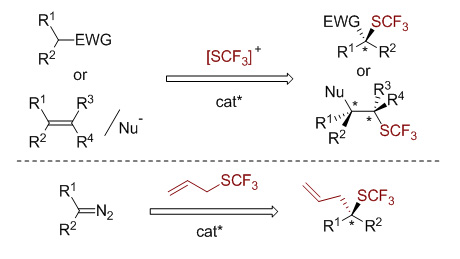| [1] (a) Hagmann, W. K. J. Med. Chem. 2008, 51, 4359.
(b) Purser, S.; Moore, P. R.; Swallow, S.; Gouverneur, V. Chem. Soc. Rev. 2008, 37, 320.
(c) Manteau, B.; Pazenok, S.; Vors, J.-P.; Leroux, F. R. J. Fluorine Chem. 2010, 131, 140.
(d) Gillis, E. P.; Eastman, K. J.; Hill, M. D.; Donnelly, D. J.; Meanwell, N. A. J. Med. Chem. 2015, 58, 8315.
[2] (a) Leo, A.; Hansch, C.; Elkins, D. Chem. Rev. 1971, 71, 525.
(b) Hansch, C.; Leo, A.; Unger, S. H.; Kim, K. H.; Nikaitani, D.; Lien, E. J. J. Med. Chem. 1973, 16, 1207.
[3] For recent reviews on trifluoromethylthiolation, see:(a) Toulgoat, F.; Alazet, S.; Billard, T. Eur. J. Org. Chem. 2014, 2014, 2415.
(b) Shao, X.; Xu, C.; Lu, L.; Shen, Q. Acc. Chem. Res. 2015, 48, 1227.
(c) Xu, X.-H.; Matsuzaki, K.; Shibata, N. Chem. Rev. 2015, 115, 731.
(d) Zhang, K.; Xu, X.; Qing, F. Chin. J. Org. Chem. 2015, 35, 556(in Chinese). (张柯, 徐修华, 卿凤翎, 有机化学, 2015, 35, 556.)
(e) Xu, J.; Chen, P.; Ye, J.; Liu, G. Acta Chim. Sinica 2015, 73, 1294(in Chinese). (徐佳斌, 陈品红, 叶金星, 刘国生, 化学学报, 2015, 73, 1294.)
(f) Zheng, H.; Huang, Y.; Weng, Z. Tetrahedron Lett. 2016, 57, 1397.
(g) Li, G.; Sun, D. Chin. J. Org. Chem. 2016, 36, 1715(in Chinese). (李恭铭, 孙德群, 有机化学, 2016, 36, 1715).
(h) Barata-Vallejo, S.; Bonesi, S.; Postigo, A. Org. Biomol. Chem. 2016, 14, 7150.
(i) Guo, Y.; Huang, M.-W.; Fu, X.-L.; Liu, C.; Chen, Q.-Y.; Zhao, Z.-G.; Zeng, B.-Z.; Chen, J. Chin. Chem. Lett. 2017, 28, 719.
(j) Zhang, P.; Lu, L.; Shen, Q. Acta Chim. Sinica 2017, 75, 744(in Chinese). (张盼盼, 吕龙, 沈其龙, 化学学报, 2017, 75, 744.)(k)Zhao, X.; Li, T.; Tian, M.; Su, Z.; Wei, A.; Lu, K. Chin. J. Org. Chem. 2018, 38, 677(in Chinese). (赵霞, 李天骄, 田苗苗, 苏志扬, 魏奥琪, 芦逵, 有机化学, 2018, 38, 677.)
[4] Bootwicha, T.; Liu, X.; Pluta, R.; Atodiresei, I.; Rueping, M. Angew. Chem., Int. Ed. 2013, 52, 12856.
[5] Wang, X.; Yang, T.; Cheng, X.; Shen, Q. Angew. Chem., Int. Ed. 2013, 52, 12860.
[6] Rueping, M.; Liu, X.; Bootwicha, T.; Pluta, R.; Merkens, C. Chem. Commun. 2014, 50, 2508.
[7] Zhu, X.-L.; Xu, J.-H.; Cheng, D.-J.; Zhao, L.-J.; Liu, X.-Y.; Tan, B. Org. Lett. 2014, 16, 2192.
[8] Yang, T.; Shen, Q.; Lu, L. Chin. J. Chem. 2014, 32, 678.
[9] Liao, K.; Zhou, F.; Yu, J.-S.; Gao, W.-M.; Zhou, J. Chem. Commun. 2015, 51, 16255.
[10] Zhao, B.-L.; Du, D.-M. Org. Lett. 2017, 19, 1036.
[11] Li, M.; Xue, X.-S.; Cheng, J.-P. ACS Catal. 2017, 7, 7977.
[12] Deng, Q.-H.; Rettenmeier, C.; Wadepohl, H.; Gade, L. H. Chem.-Eur. J. 2014, 20, 93.
[13] Jin, M. Y.; Li, J.; Huang, R.; Zhou, Y.; Chung, L. W.; Wang, J. Chem. Commun. 2018, 54, 4581.
[14] Zhang, H.; Leng, X.; Wan, X.; Shen, Q. Org. Chem. Front. 2017, 4, 1051.
[15] Chachignon, H.; Kondrashov, E. V.; Cahard, D. Adv. Synth. Catal. 2018, 360, 965.
[16] Liu, X.; An, R.; Zhang, X.; Luo, J.; Zhao, X. Angew. Chem., Int. Ed. 2016, 55, 5846.
[17] Luo, J.; Liu, Y.; Zhao, X. Org. Lett. 2017, 19, 3434.
[18] Luo, J.; Cao, Q.; Cao, X.; Zhao, X. Nat. Commun. 2018, 9, 527.
[19] Liu, X.; Liang, Y.; Ji, J.; Luo, J.; Zhao, X. J. Am. Chem. Soc. 2018, 140, 4782.
[20] Zhang, Z.; Sheng, Z.; Yu, W.; Wu, G.; Zhang, R.; Chu, W.-D.; Zhang, Y.; Wang, J. Nat. Chem. 2017, 9, 970.
[21] Xu, L.; Wang, H.; Zheng, C.; Zhao, G. Adv. Synth. Catal. 2017, 359, 2942.
[22] Hock, K. J.; Koenigs, R. M. Angew. Chem., Int. Ed. 2017, 56, 13566.
[23] Mao, G.; Chen, L.; Wang, C. Sci. China Chem. 2017, 60, 1565. |
